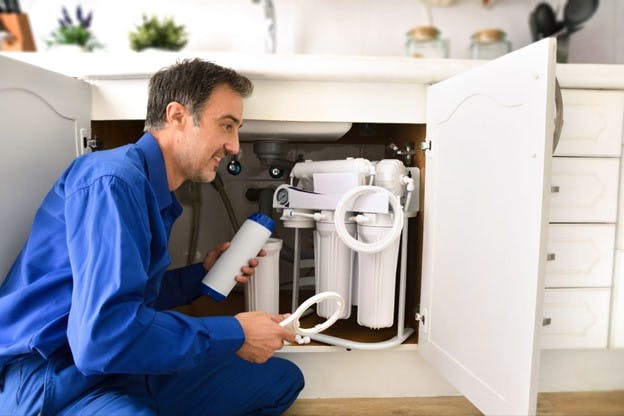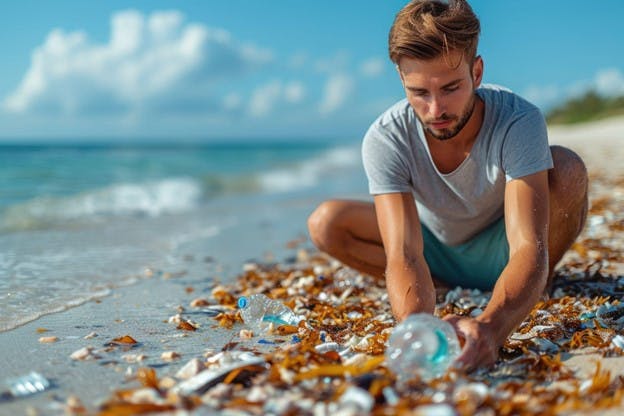🌟 New Arrival! Upgrade Your Water with Our Advanced Pitcher Filter. Shop Now
April 2024
Water Pollution and Quality: Unraveling the Facts
Key Takeaways
- Pollution poses a significant risk to water quality and human health worldwide.
- Understanding the sources and impacts of water pollution and quality is crucial for implementing targeted mitigation strategies and protecting water resources for future generations.
- PFAS, microplastics, and pharmaceuticals pose new challenges, underscoring the need for awareness and regulation to protect water resources and public health.
- Investing in home water filtration systems can safeguard against the dangers of water pollution and emerging contaminants, ensuring clean and safe drinking water for your family.
Water is one of the most abundant and natural resources on Earth. However, more than 2 billion people worldwide lack access to safely managed drinking water services. This poses an ongoing risk for years to come.
Over the past few decades, our water resources have become increasingly threatened by widespread water pollution and quality issues. A report by the United Nations revealed that 80% of wastewater is discharged back into the ecosystem without treatment. Projections show that factors such as climate change and population growth will further heighten the water pollution problem.
In this article, we’ll delve into the intricate relationship between water pollution and quality of the water you drink, highlighting important impacts and how you can combat risks.
Understanding Water Pollution and Quality Impact
Water pollution refers to contamination of water bodies like rivers, lakes, oceans, and reservoirs. These contaminants degrade the quality of water, making it unsafe for humans and other species. Water quality is a measure of several physical, chemical, and biological characteristics including:
- pH
- Temperature
- Dissolved oxygen (DO)
- Nutrients
- Heavy metals
- Micro-organisms
- Organic matter
Pollution affects water quality by introducing chemicals, pathogens, excessive nutrients, and sediments into water sources. It can also reduce the amount of dissolved oxygen in water, affecting its life-sustaining qualities. Polluted water is characterized by turbidity, altered coloration, and unpleasant odors.
Generally, there are three types of water pollution:
- Point source pollution: Pollution that originates from identifiable and localized sources, such as industrial discharges and sewage treatment plants.
- Non-point source pollution: Pollution that arises from diffuse sources, such as agricultural runoff, urban stormwater runoff, and atmospheric deposition.
- Transboundary pollution: Pollution that crosses political boundaries, posing challenges for effective regulation and management.
It's important to understand these different forms of pollution so we can implement targeted and sustainable strategies to mitigate effects. By addressing the root causes rather than the outcome, we're more likely to restore and preserve the integrity of our water resources.
What Are the Sources of Water Pollution?
There are many sources of water pollution. Human activities are the most common cause of water pollution and quality reduction, though natural events can sometimes contribute to pollution too. By understanding the causes, we can implement steps to reduce or get rid of water pollution.
Let’s look at the most common causes of water pollution.
1. Industrial Activities
Industrial factories and plants discharge various pollutants into water bodies, including heavy metals, chemicals, and toxins. Effluents from factories and manufacturing plants can contaminate water sources, posing significant risks to aquatic ecosystems and human health.
Apart from directly discharging pollutants into water sources, industrial activities cause widespread air pollution. During rainfall, toxic contaminants dissolve in rainwater and end up in groundwater. This changes the chemical composition of water bodies, affecting water quality.
2. Agricultural Activities
Agriculture is not only the biggest consumer of the world’s freshwater resources, but it’s also one of the most common causes of water pollution. Large-scale agricultural activities often make use of fertilizers, pesticides, and other chemicals. Agricultural runoff containing these substances finds its way into water bodies, affecting water quality and the balance and survival of aquatic ecosystems.
3. Urbanization and Stormwater Runoff
Urban development involves the construction of impervious surfaces like roads and buildings. Impervious surfaces alter natural water flow patterns. Stormwater runoff picks up pollutants such as oil, debris, and chemicals from urban areas, carrying them into waterways and degrading water quality.
4. Inadequate Waste Management
Many parts of the world, especially developing countries, are still struggling with waste management amid rapid population growth. Improper disposal of household, industrial, and hazardous waste can result in the contamination of water bodies.
5. Deforestation and Soil Erosion
Deforestation and soil erosion contribute to sedimentation in water bodies, reducing water clarity and suffocating aquatic habitats. Sediments can also transport attached pollutants, such as pesticides and heavy metals, further compromising water quality.
6. Mining Activities
Mining operations release various pollutants, including heavy metals, acids, and sediments, into nearby water bodies. Acid mine drainage, a common issue in mining areas, can severely degrade water quality and harm aquatic life. Offshore mining rigs spill oil onto the ocean surface, cutting off the oxygen supply for marine life below the surface.
7. Climate Change
Climate change worsens water pollution and quality in several ways. Higher water temperatures may favor the growth of certain pathogens, while floods may accelerate the sedimentation of particles into water bodies and increase the rate and quantity of affluents carrying other pollutants.

What Are the Effects of Water Pollution?
Freshwater is vital for the survival and well-being of humans, animals, and the environment. The effects of water pollution and quality degradation are diverse, affecting the environment, human health, and the livelihoods of communities worldwide. The most pressing effects of water pollution are:
1. Poor Human Health
Contaminated water poses one of the most significant public health challenges. Pathogens in polluted water are responsible for life-threatening diseases such as cholera, typhoid, and hepatitis A. While this is more common in developing economies, toxic contaminants such as heavy metals are found in water sources around the world. Prolonged exposure to toxic chemicals can cause many chronic diseases, ranging from neurological disorders to reproductive defects and cancers.
2. Ecosystem Degradation
Water pollution disrupts the delicate balance in aquatic ecosystems. Contaminants in polluted water can harm aquatic organisms either by disrupting their reproduction, reducing their food sources, or causing death. This results in the loss of biodiversity and the alteration of the balance in natural ecosystems.
3. Economic Burden on Governments and Families
Water pollution imposes substantial economic costs on societies. Expenses related to health care, water treatment, and ecosystem restoration often consume a sizable chunk of money. Industries reliant on clean water, such as fisheries, agriculture, and tourism, can suffer financial losses due to declines in water quality.
Access to clean drinking water is still a major challenge for a huge part of the population, and governments have to bear this burden. According to UNICEF, developing countries need up to $114 billion per year to meet the water, sanitation, and hygiene(WASH)-related SDG targets by 2030. These massive costs will slow down economic growth in countries that need it the most.
4. Algal Blooms and Dead Zones
Fertilizers and animal waste from agricultural activities cause nutrient enrichment in large water bodies, resulting in harmful algal blooms that alter the balance in aquatic ecosystems. Nitrates and phosphorus are abundant in many fertilizers because they help plants grow. However, they also cause excessive nutrient enrichment of water bodies, a process called eutrophication. Eutrophication leads to overgrowth of algae and other aquatic plants.
Algal blooms are characterized by rapid and excessive growth of algae in water bodies. These blooms can deplete oxygen levels, leading to the formation of dead zones where aquatic life cannot survive, further worsening ecosystem degradation.
How Can We Combat Water Pollution?
Without adequate measures to curb the problem, the environment and many parts of the population will continue to suffer the detrimental effects of water pollution. Some measures to combat water pollution are:
- Ensuring adequate wastewater treatment
- Establishing regulatory frameworks that address pollution
- Investing in pollution control and reduction technologies
- Banning widespread deforestation and encouraging reforestation
- Implementing green infrastructure solutions to manage stormwater runoff
- Creating public awareness of and educating the public on how to reduce pollution
Oversight authorities like the Environmental Protection Agency (EPA) are responsible for setting water quality standards and monitoring compliance by industries and other stakeholders. All in all, a multifaceted approach that brings different stakeholders on board is needed to successfully combat water pollution and quality issues. In addition, continued research and monitoring is also necessary to accelerate and track the pollution reduction progress.

Emerging Contaminants: Challenges to Water Quality
There’s been a rise of new contaminants often overlooked by traditional oversight authorities. These contaminants are slowly becoming a public health threat. There's a pressing need to create awareness of their existence and establish quality control standards to ensure drinking water is safe from these substances. Among the most concerning emerging contaminants are:
1. Per- and Polyfluoroalkyl Substances (PFAS)
PFAS are a group of synthetic chemicals used in a wide range of industrial and consumer products, including firefighting foams, non-stick cookware, and waterproof textiles. PFAS belong to a group of substances commonly referred to as “forever chemicals” because they are resistant to degradation and remain in the environment for years.
PFAS have emerged as a significant cause of water contamination. Despite their toxic effects on human health, many people around the world are unaware of their existence. In the United States, recent reports indicate that more than 200 million people could potentially be exposed to PFAS in their drinking water at levels that could impact their well-being. Ensuring you drink PFAS-free water will go a long way in helping you avert the health effects of these toxic compounds.
2. Microplastics
Microplastics are tiny particles of plastics measuring less than millimeters in size. They are derived from the physical breakdown of plastics. Microplastics usually end up in large water bodies, causing both physical and chemical harm to aquatic animals. Microplastics have been found in fish and other species humans consume.
There are limited human-based studies detailing the health effects of microplastics. However, animal studies, like one on tissue accumulation of microplastics in mice, show concerns. Microplastics accumulate in the kidneys, liver, and gut, affecting energy, fat metabolism, and biomarkers indicating toxicity.
In good news, a recent study published in Environmental Science & Technology Letters suggests that boiling mineral-rich tap water for five minutes can reduce exposure to nanoplastics and microplastics (NMPs) by up to 90%. However, it's still unclear whether boiling drinking water removes PFAS as well.
3. Pharmaceuticals and Personal Care Products (PPCPs)
PPCPs are among the most widely used synthetic chemical products in the world. Prescription drugs, over-the-counter medications, and cosmetic products have been detected in water bodies worldwide. Improper disposal of PPCPs coupled with wastewater runoff in urban areas dumps these chemicals into large water bodies. While they may exist in very low concentrations, continued exposure and their interaction with other pollutants may affect human health.

Enjoy Clean, Pollution-Free Drinking Water at Home
Water pollution and quality of our drinking water is a rising global concern affecting a significant part of the population. Pollution of water sources introduces contaminants that are harmful to human health into public water systems. As a result, access to clean and safe drinking water is becoming more and more difficult, especially with the increase of little-known emerging contaminants like PFAS. Want to protect your family from contaminants in drinking water?
Discover unrivaled water clarity with our HomeWater UPSTREAM™ 4-Stage Whole Home Water Filter. Our advanced filtration technology targets pollutants such as heavy metals, pesticides, PFOS/PFAS, and microplastics, ensuring that every drop of water that flows from your faucet is clean, pure, and safe to drink. With easy installation and low maintenance, the HomeWater UPSTREAM™ 4-Stage Whole Home Water Filter provides peace of mind knowing that your family's health and well-being are protected from the dangers of water pollution.